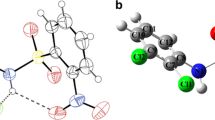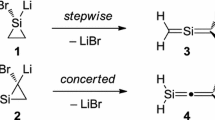Abstract
The reaction of C60 fullerene dissolution in monosubstituted benzenes has been studied. The correlation method of physical properties of solvent molecules with reaction characteristics has been applied under the assumption of their donor-acceptor mechanism. The effect of electron-donor substituents of aromatic ring has been found.
Access this chapter
Tax calculation will be finalised at checkout
Purchases are for personal use only
Similar content being viewed by others
Abbreviations
- QSPR:
-
quantitative structure-property relationship
- QSAR:
-
quantitative structure activity relationship
- HOMO:
-
high occupied molecular orbital
- LFMO:
-
lower free molecular orbital
- LCM:
-
liquid-crystal media
- DAC:
-
donor-acceptor complex
- DAI:
-
donor-acceptor interaction
- CCT:
-
complex with charge transfer
- HB:
-
hydrogen bond
- Cs :
-
concentration of solvent
- CCCT :
-
concentration of CCT
- \( {S_{{{C_{{60}}}}}} \) :
-
solubility of C60
- μHB :
-
dipole moment of halogen benzene
- MHB :
-
mesomeric effect of halogen benzene
- μFB :
-
dipole moment of fluorine benzene
- HC:
-
hyperconjugation
- ϕAB :
-
ionization potential of alkyl benzene
- χ:
-
electronegativity
References
Ruoff RS, Tse DS, Malhotra P, Lorents DC (1993) Solubility of fullerene C60 in a variety of solvents. J Phys Chem 97(13):3379–3383
Bezmel'nitsyn VN, Eletskii AV, Okun MV (1998) Fullerenes in solutions. Phys Usp 41:1091–1114
Eletskii AV, Smirnov BM (1995) Fullerenes and carbon structures. Phys Usp 38:935–964
Smith AL, Wilson LY, Famini GR (1996) Quantitative structure - property relationship study of C60 solubility, recent advances in the chemistry and physics of fullerenes and related materials. Los Angeles, CA
Marcus Y (1997) Solubilities of buckminsterfullerene and sulfur hexafluoride in various solvents. J Phys Chem B 101(42):8617–8623
Kamlet MJ, Abboud JLM, Taft RW (1981) An examination of linear solvation energy relationships. Progr Phys Org Chem 13:485–630
Makitra RG, Pristanskii RE, Flyunt RI (2003) Solvent effects on the solubility of C60 fullerene. Russ J Gen Chem 73(8):1227–1232
Kiss IZ, Mandi I, Beck MT (2000) Artifical neural network approach to predict the solubility of C60 in various solvents. J Phys Chem A 104(20):8081–8088
Abraham MH, Green CE, Acree WE (2000) Correlation and prediction of the solubility of buckminsterfullerene in organic solvents, estimation of some physico-chemical properties. Chem Soc Perkin Trans II 2:281
Sivaraman N, Srinivasan TG, Rao PRV, Natarajan RN (2001) QSPR modeling for solubility of fullerene C60 in organic solvents. J Chem Inf Comput Sci 41(4):1067–1074
Hansen CM, Smith AL (2004) Using Hansen solubility parameters to correlate solubility of C60 fullerene in organic solvents and in polymers. Carbon 42(8–9):1591–1597
Dubois D, Kadish KM, Flanagan S, Wilson LJ (1991) Electrochemical detection of fulleronium and highly reduced fulleride (\( {\hbox{C}}_{{60}}^{{5 - }} \)) ions in solution. J Am Chem Soc 113:7773–7774
Arbogast JW, Foote CS, Kao M (1992) Electron-transfer to triplet C60. J Am Chem Soc 114:2277
Hirsch A (1993) The chemistry of the fullerenes: an overview. Angew Chem 32(8):1138–1141
Tayior R, Walton DMR (1993) The chemistry of the fullerenes. Nature 363:685–693
Wang Y (1992) Photophysical properties of fullerenes and fullerene/N, N-diethylaniline charge-transfer complexes. J Chem Phys 96(2):764–767
Caspar JV, Wang Y (1994) Excited state electron transfer of fullerenes. Singlet states versus triplet states. Chem Phys Lett 218(3):221–228
Kotov AI, Konovalikhin SV, Pisarev PV, Shilov GV et al. (1994) Preparation and X-ray study of a molecular complex of C60 with a new organic cyclotetrasulfide, 4C60 3 (twin TDAS). Mendeleev Commun 4(5):180–182
Kamanina NV (2005) Fullerene-dispersed nematic liquid crystal structures: dynamic characteristics and self-organization processes. Phys Usp 48(4):419–427
Evlampieva NP, Yakimanskii AV, Dobrodumov AV et al (2005) Synthesis, polar and electrooptical properties of butylaminoderivative of fullerene C60. J Gen Chem 75(5):795–802, in Russian
Beck MT, Mandi G, Keki S (1995) Fullerene Sci Technol 2:1510
Beck MT, Mandi G (1996) Fullerenes Sci Technol 3:32
Scrivens WA, Tour JM (1993) Potent solvents for C60 and their utility for the rapid acquisition of 13 C-NMR data for fullerenes, Phys Inorg Chem 24(44):1207
Bekker G (1965) Introduction to the electronic theory of organic reactions, Moscow: Mir, p 576 (in Russian)
Schur DV, Zaginaichenko SYu, Anikina NS, Matysina ZA, Krivuschenko OYa, Skorokhod VV (2009) The discovery of “ordering effect” in meta-isomer, the product of benzene mono-derivative nitration and relation between this effect and reactivity of monosubstituted benzenes in the reactions of intermolecular donor-acceptor interaction with C60 fullerene. In: Book of abstracts of Proceeding of 11th international conference “hydrogen materials science and chemistry of carbon nanomaterials”, Yalta, Crimea, 25–31 Aug 2009, pp 604–605
Anikina NS, Schur DV, Zaginaichenko AD, Zolotarenko AD et al. (2007) On the donor-acceptor mechanism of fullerene C60 dissolution in aromatic hydrocarbons. In: Book of abstracts of 10th international conference “hydrogen materials science and chemistry of carbon nanomaterials”, Sudak, Crimea, 22–28 Sept 2007, pp 672–677
Neiland O Ya (1990) Organic chemistry. Moscow: Vysshaya shkola, p 750 (in Russian)
Anikina NS, Schur DV, Zaginaichenko AD, Golovchenko TN et al. (2009) About physical nature of ionization potentials of benzene mono-derivatives and C60 fullerene solubility in these compounds. In: Book of abstracts of 11th international conference “hydrogen materials science and chemistry of carbon nanomaterials”, Yalta, Crimea, 25–31 Aug 2009, pp 796–799
Schur DV, Anikina NS, Krivuschenko OYa, Voronaya TV et al. (2009) About fullerene C60 solubility in mono- and polysubstituted benzenes, fullerene constantans of substituents and ionization energy of substituents. In: Book of abstracts of 11th international conference “hydrogen materials science and chemistry of carbon nanomaterials”, Yalta, Crimea, 25–31 Aug 2009, pp 1166–1167
Toporov AA, Leszczynska D, Leszczynski J (2007) QSPR study on solubility of fullerene C60 in organic solvents using optimal descriptors calculated with SMILES. Chem Phys Lett 441(1–3):119–122
Knunyants IL (1992) Chemical encyclopedia, Moscow: Solvent encyclopedia, 3:641 (in Russian)
Author information
Authors and Affiliations
Corresponding author
Editor information
Editors and Affiliations
Rights and permissions
Copyright information
© 2011 Springer Science+Business Media B.V.
About this paper
Cite this paper
Anikina, N.S., Krivuschenko, O.Y., Schur, D.V., Zaginaichenko, S.Y., Kamenetskaia, E.A. (2011). Special Features and Regularities of Interaction Between Fullerene Molecules and Aromatic Solvents. In: Zaginaichenko, S., Schur, D., Skorokhod, V., Veziroglu, A., İbrahimoğlu, B. (eds) Carbon Nanomaterials in Clean Energy Hydrogen Systems - II. NATO Science for Peace and Security Series C: Environmental Security, vol 2. Springer, Dordrecht. https://doi.org/10.1007/978-94-007-0899-0_4
Download citation
DOI: https://doi.org/10.1007/978-94-007-0899-0_4
Published:
Publisher Name: Springer, Dordrecht
Print ISBN: 978-94-007-0898-3
Online ISBN: 978-94-007-0899-0
eBook Packages: Chemistry and Materials ScienceChemistry and Material Science (R0)




